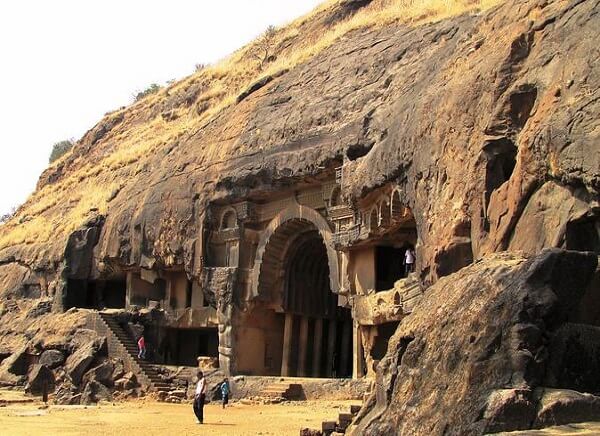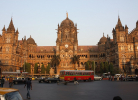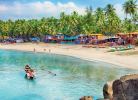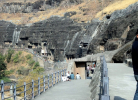Kanheri Caves, Mumbai
Visitor Information:

-
Famous For History, Photography, Sculptures, Carvings
-
Fee Guide in Detailed Below
-
Visiting Time
-
Duration of Visit 5:30Am to 7:30PM
Kanheri Caves is one of the famous groups of cave monuments of India. This group holds numerous rock-cut structures made out of basalt rock during ancient times.
These caves are famous for sculptures, carvings, inscriptions, and paintings, which give an insight into the culture, teaching, religion, and lifestyle of ancient Indians.
History of Kanheri Caves
The term Kanheri is derived from an ancient word Krishnagiri, which means Black Mountain. The carvings and inscriptions of these caves belong to various reigns betweenthe 1st century BC and 10th century AD. This group of caves is also famous for being the largest number of excavations done from a single hill.
The first cave of this group was excavated during the spreading of Buddhism in Sopara region.
Most of the caves were plain monasteries which were meant for meditating, studying and other religious purposes. The cave monuments were made in the trade route of Maharashtra and it also served as an accommodation option for merchants and travelers.
Chaitya Hall served as the main worship area. Kanheri thrives for more than a millennium because of its proximity to the port towns. The construction works were sponsored by various rulers of different reigns.
Architecture of Kanheri Caves
These caves are made from basalt formations. The caves show ancient Indian religious architecture, which is similar to other cave structures of India like Ajanta, Ellora, Elephanta, and others. The construction of these caves started during the Hinayana period and their influence of the architecture is clearly seen.
The later caves have a fusion of Mahayana period architecture and iconic Buddhist religious architecture. Most of the sculptures of this region were built during the Mahayana period.
Water cisterns are found in almost all the caves providing water supply even during the peak summer. There are also inscriptions, which mentioned a dam construction.
Inside Kanheri Caves
There are more than 109 caves in this collection which were used between the 1st century BC and 11th century AD. Interestingly, almost all the caves have a small plinth made entirely with stone. It is assumed that the plinth was used as a bed.
Many caves hold large congregation hall supported by mammoth pillars.
These are Buddhist shrines, which were used for religious and spiritual purposes. The caves, which were used as monasteries have beautiful reliefs of Bodhisattvas and Buddha. Among the 109 caves, here are the top caves of importance.
Cave 1
This cave is a vihara (monastery). The entrance of this cave is supported by large pillars of primitive structure. The cave has two levels and is incomplete.
Cave 2
This cave is very long and has three dagobas. You can find may sculpture of Buddha and other figures here.
Cave 3
This is one of the most famous caves in this group. This cave has inscriptions made in 170 AD. The temple inside the cave has 34 pillars, numerous carvings, sculptures, artworks, woodwork and so on.
The cave also holds two mammoth structures of Buddha, which are more than 23 feet of height. The cave also has a large hall with numerous figures and inscriptions. You can find numerous figures similar to Ellora caves in the verandah of the Great Chaitya Cave.
Cave 4
This cave is a small cell in circular shape with a small prayer site. You can find sculptures of Buddha and other figures in this cave. The columns of this cave are similar to Elephanta Caves and the interior work is incomplete. This belongs to the 10th century AD.
Cave 5 and 6
These are water cisterns with inscriptions about a queen and other royals of Karddamaka dynasty
Cave 11
This is a darbar cave, which holds the name of an ancient king. This is a place of assembly and was used to conduct the first meeting after the death of Lord Buddha.
You can find many sculptures and paintings in this assembly hall, which can accommodate more than 500 people at the same time. Stone benches can also be found. The carvings are similar to the famous Viswakarma Temple of Ellora Caves.
Cave 31
A simple cave with a shrine and a small stupa
Cave 32
Famous for courtyard, hall and octagonal pillars. There are inscriptions about the sponsor of the cave and the records indicate that the cave was excavated during the 4th century AD.
Cave 33
This is a group of four caves with relic mounts, brick stupas, cells, and Buddha seals. Two stone urns containing copper coins were found in this cave, belonging to 15th century AD.
Cave 34
This cave is famous for roof painting and this is the only cave with painting seen in this group of caves.
Cave 41
This is a vihara with many advanced styled carvings like elephant pillars and others, similar to Ajanta caves. You can find a small shrine, relief of Buddha, sculptures, and others. You can also find litany holding four compartments on either side. This is one of the latest caves in the group.
Cave 67
Avihara with verandah, pillars, and sculptures.
Cave 78
This cave is famous for inscriptions, pillars, carvings, and others.
Cave 84
Famous for brick stupas and a gallery. No relics are found in this cave. This cave was used for preaching and learning.
Cave 89
This cave has many carvings made during the Hinayana reign. You can find sculptures of Buddha, Avalokiteshvara, Bodhisattva and other figures in this cave. There is a small hall with more sculptures and a verandah.
Cave 90
This holds a litany with sculptures of Buddha and other figures. You can also find Mahayana sculptures n this cave. The verandah has many inscriptions in tabular form.
Paintings of Kanheri Caves
There are more than 30 unfinished paintings in this group of caves, all found in the same cave. Roof paintings are the iconic element of this group of caves in the painting genre. The paintings were found only in the later caves. The painting styles belong to the style of Amaravati art schools of the past.
Only Cave 34 has some of the remains of the painting. No lithic carving styled paintings are found here. Most of the paintings of this group of caves did not survive.
Trek of Kanheri Caves
These mountain caves can be reached via rock-cut primitive steps. The cave is around 5 km inside the famous Sanjay Gandhi National Park.
If you choose to trek to the caves, you are not alone. It would take around two hours to trek to the caves through the forest region. The terrain is simple and easy for novice trekkers too. The view would be mesmerizing and you can find many waterfalls and tribal communities along the route.
There are seven natural trails for trekking and the fee for trekking ranges between INR 75 to INR 300 per head, based on the trail and season. If you want to hire a naturalist to guide you, the cost of a guide is INR 1000.
If you missed out on booking for trails, the only trekking route that can does not need booking or guide is the Nagla Block Trail, which starts from Sasupada Village and ends at Vasai Creek.
Waterfall
You can find numerous small and large waterfalls around the region. This is one of the best parts about trekking to the caves from the entrance of the park. These waterfalls were channeled into water cisterns and were used for drinking purposes by the monks.
Later, the major waterfall region was used by Hindus to build a temple for Lord Shiva. Thus, the southern caves were the only ones with water support. Thus, many tanks were erected to hold water.
Visit during monsoon to spot as many waterfalls as possible in this region.
Entry Fee of Kanheri Caves
For entry into the park:
- Children between the age of 5 and 12 – INR 28 per head
- Above the age of 12 – INR 53 per head
- Below the age of 5 – free to visit
- Motorcycle entry – INR 45
- Car entry – INR 177
- Bus entry – INR 266
- For visiting the caves (in addition to the above cost):
- 15 per head for Indians
- INR 200 per head for Foreigners
- A shuttle runs from the entrance to the cave (once every hour): INR 48 for adults and INR 25 for children (one-way)
Visiting Timing of Kanheri Caves
It remains Closed on Mondays.
- Open from 5:30 am to 7:30 pm (park)
- The entry to cave closes by 6:30 pm
Best Time To Visit Kanheri Caves
The best time to visit to explore the caves with ease and for easy transportation is between September and March. This is the winter season and the waterfalls will be lush with water with the routes being dry.
Thus trekking is also quite easy. However, this is the prime tourism season and thus, the park might be crowded and chances of finding shuttle services to the cave from the entrance of the park are quite hard.
Also Read : Best Time to Visit Mumbai
How To Reach Kanheri Caves
The caves are located inside Sanjay Gandhi National Park of North Mumbai. From Borivali or other stations along the western line, you can take metro trains to reach the region.
From the entrance of the park, you can find auto-rickshaws to take you to the entrance of the cave. From the entrance, you can also hire a cycle at the cost of INR 60 per two hours with a deposit of INR 300 and an ID proof.
By Car:
You can find cabs from several parts of the country to the park. From the park, you can choose to reach the caves in your vehicle or hire park vehicles.
By Train:
The closest railway station to the park is located at Malad and Borivali. From the stations, you can find cabs and other road transportation to reach the national park.
From the entrance of the park, you need to opt for the shuttle to the caves or trek your way.
Reaching Kanheri Caves from Other Cities
Kanheri Caves are not just accessible from Mumbai but it can be reach from other major cities too
How to Reach Kanheri Caves from Thane
Distance : 30 km (1 hour and 11 minutes of travel)
From Thane, you can find metro trains and road transportation to reach the national park. If you are choosing trains, you should de-board at Borivali station and from there, you can find road transportation to reach the caves.
How to Reach Kanheri Caves from Dadar
Distance : 35 km (1 hour and 31 minutes of travel)
From Dadar railway station to Borivali, you can find trains, which would take one hour and six minutes to reach. You can also find buses and cabs from Dadar to Kanheri.
How to Reach Kanheri Caves from Borivali
Distance : 10 km (36 minutes)
From Borivali, you can find cabs and buses to reach the entrance of the park.
Also Read : How to Reach Mumbai























